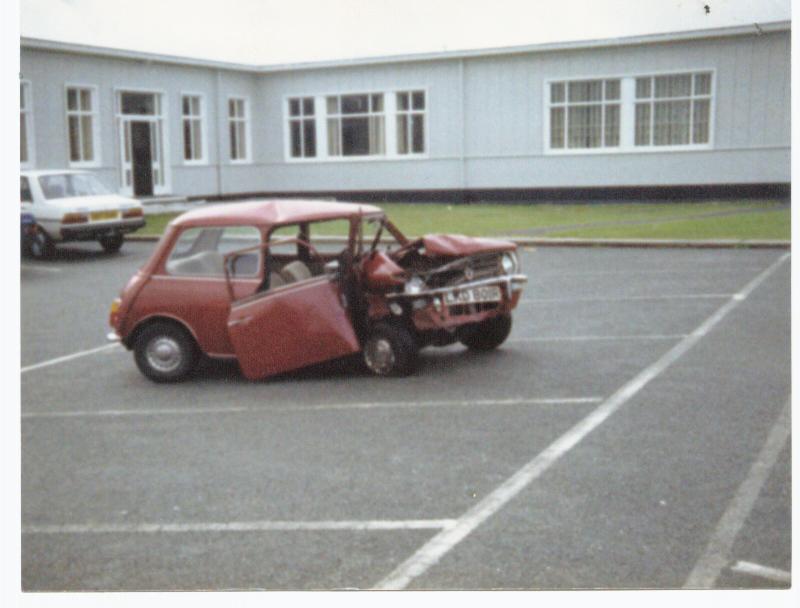
Creating Custom Wiring Loom
Started by
Pavel
, Aug 20 2004 06:01 PM
11 replies to this topic
#1

Posted 20 August 2004 - 06:01 PM
I'm gonna rewire the entire car.
I need some help though with essential things to make sure I don't miss them out. I'll figure out wiring for accessories, radio etc, lights, myself. But things like ignition, indicators, hazards, brake pedal switch etc. I would like some basic help with.
I'll be using a custom fusebox (to accept spade fuses) in the glovebox, so I can use quite a number of fuses!
I need help with follwoing:
Indicators, hazards, how are they meant to be wired up to basic toggle switches (2 pin) and how do I connect them to the hazard and flasher units?
Windshield wiper connections
Coil connection, distributor. Is this as straightforward as I think it is? Coil gets a constant positive 12v feed when ignition is turned on, and negative end of coil is connected to distributor with a white/black wire?
Temperature gauge... I have the sensor in the head, but what do I do to connect a gauge, must I go through the voltage regulator? which brings me to the next point:
Voltage regulator. Do I need it? How does it wire in with the rest of the stuff in the car?
Sorry if this seems a bit patchy, but I just need some basic information on rewiring a car completely so i can plan it out and see what and how much of each colour wires i'll need...
I need some help though with essential things to make sure I don't miss them out. I'll figure out wiring for accessories, radio etc, lights, myself. But things like ignition, indicators, hazards, brake pedal switch etc. I would like some basic help with.
I'll be using a custom fusebox (to accept spade fuses) in the glovebox, so I can use quite a number of fuses!
I need help with follwoing:
Indicators, hazards, how are they meant to be wired up to basic toggle switches (2 pin) and how do I connect them to the hazard and flasher units?
Windshield wiper connections
Coil connection, distributor. Is this as straightforward as I think it is? Coil gets a constant positive 12v feed when ignition is turned on, and negative end of coil is connected to distributor with a white/black wire?
Temperature gauge... I have the sensor in the head, but what do I do to connect a gauge, must I go through the voltage regulator? which brings me to the next point:
Voltage regulator. Do I need it? How does it wire in with the rest of the stuff in the car?
Sorry if this seems a bit patchy, but I just need some basic information on rewiring a car completely so i can plan it out and see what and how much of each colour wires i'll need...
#2

Posted 20 August 2004 - 06:08 PM
you need the voltage regulator for your fuel gauge and your temp gauge.
#3

Posted 20 August 2004 - 06:30 PM
the best advice i can give for customising the rewiring of your car is to mark up all the wires as to what they are conected to, then take out the wiring loom completlly. lay it out as it fits into the car on a large enough space, with all the switches connected, remove all the wrapping from the wires so that they are loose, this way you will be able to see how most thing are wired up.
i would recomend that you make a wiring diagram specific for your car if you are changing or adding wire's, that way if you have trouble in the future you will be able to fault find it..
you will be able to use toggle switches for the basic functions, ign, heater, rear window, and posably lights, though main/dip will need a seperate switch, indicators will be a differant matter, because they work through the hazard switch, i don't think you will be able to toggle them.
i will think some more on this matter, as to what needs what and what is needed to be legal, though something may de differant in cyprus
:wales:
i would recomend that you make a wiring diagram specific for your car if you are changing or adding wire's, that way if you have trouble in the future you will be able to fault find it..
you will be able to use toggle switches for the basic functions, ign, heater, rear window, and posably lights, though main/dip will need a seperate switch, indicators will be a differant matter, because they work through the hazard switch, i don't think you will be able to toggle them.
i will think some more on this matter, as to what needs what and what is needed to be legal, though something may de differant in cyprus
:wales:
#4

Posted 20 August 2004 - 06:36 PM
Not all makes of gauges need a voltage regulator as some are internally regulated, and digital ones are very different anyway. But if you are using standard clocks or Smiths Classics or something like that then you do need it. It is used for oil or water temp and fuel level but not pressure gauges. It uses an accessory live feed and an earth and outputs a constant (ish) regulated (ish) 12volts so that the gauge calibration is accurate, 'because bi-metal gauges run as bridge circuits comparing the resistance of the gauge to that of the sender so they need a known voltage supply. So they have three terminals, feed earth and instrument supply (reg'd). Each one can drive up to three gauges.
You can't use an on/off switch to run hazards (without using like seven relays) and you cant use a single pole changeover either, not with any of the standard flasher units anyway. Philster says he has a Ford flasher which can be wired using a single pole changeover but unfortunately I don't think he'll have much success as all car makers OE hazard switches are four pole changeover unless they have complex body computers, and then you'd have to use the whole computer which isn't usually possible due to coding issues.
The easiest way to wire one (toggle switch that is, I assume that's what you want)without huge messy relay arrangements (which risk blowing up any electronic components in your car by the way, due to induced back emf) is to use a four pole toggle. I can send you a diagram if you want.
You can use toggles for everything, if you can find the right ones. I posted about toggles before, HERE.
You can't use an on/off switch to run hazards (without using like seven relays) and you cant use a single pole changeover either, not with any of the standard flasher units anyway. Philster says he has a Ford flasher which can be wired using a single pole changeover but unfortunately I don't think he'll have much success as all car makers OE hazard switches are four pole changeover unless they have complex body computers, and then you'd have to use the whole computer which isn't usually possible due to coding issues.
The easiest way to wire one (toggle switch that is, I assume that's what you want)without huge messy relay arrangements (which risk blowing up any electronic components in your car by the way, due to induced back emf) is to use a four pole toggle. I can send you a diagram if you want.
You can use toggles for everything, if you can find the right ones. I posted about toggles before, HERE.
#5

Posted 20 August 2004 - 07:08 PM
I don't mind using a bunch of relays if need be, since I can tidy it all up anyway :]
Basically the toggle switches I have now are on:off and look like this from the back (x being terminals)
Basically the toggle switches I have now are on:off and look like this from the back (x being terminals)
Attached Files
#6

Posted 22 August 2004 - 11:18 PM
If you plan to only use double pole on/off switches, you will need to use SHITLOADS of relays hidden all over the car. Most car switchgear is specifically made for purpose 'because hardly any of it just needs to be on/off.
You probably could do it, but you would need like 30 or 40 relays in the car and that would be with using some exotic custom types. If you can only find changeover relays you're in even more trouble. And ALL of your relays would need to be diode protected (which means you can't use micro relays 'because you can't get protected ones AFAIK) 'because with that many in the car you could easily get spikes of several thousand volts when you switch stuff and that might blow up radios or flasher units. And you would need to make sure all the coils were wired the right way round so the diodes work properly.
You probably could do it, but you would need like 30 or 40 relays in the car and that would be with using some exotic custom types. If you can only find changeover relays you're in even more trouble. And ALL of your relays would need to be diode protected (which means you can't use micro relays 'because you can't get protected ones AFAIK) 'because with that many in the car you could easily get spikes of several thousand volts when you switch stuff and that might blow up radios or flasher units. And you would need to make sure all the coils were wired the right way round so the diodes work properly.
#7

Posted 23 August 2004 - 09:46 AM
surely you would only need two flasher units and then when the hazard is switched on use a relay to switch them both on at the same time?
#8

Posted 23 August 2004 - 09:09 PM
Interesting idea. Hadn't thought of that. The two things that jump out at me are how to drive the hazard warning tell-tale and how to syncronise the two flashers when the hazards are running, because no two flasher units will run at the same rate (even digital ones can be slightly different). There may be a way around this though.
#9

Posted 24 August 2004 - 07:19 AM
there is a way i think of doing this using diode's in the lines and using a seperate flasher for the hazards, that way both of them would flash at the same rate, but i think this would mean extra cable being used
not quite sure though
not quite sure though
#10

Posted 24 August 2004 - 10:41 PM
What Cowboy said made me think. So I sketched this.
I use diodes for loads of stuff and can't believe I didn't think of doing this before. Sorry to anyone I have told that this couldn't be done ( especially Philster ), 'because I think that this will work.
All the diodes are needed because without the ones from the indicator feed you could have problems with accessories being fed while the hazards are on if you left an indicator on.
It could have some problems with flash rate caused by the diodes, but I'm not sure. This diagram uses electronic flasher units which would need to be of the correct rating for each circuit. I don't think it is possible to use a towing compatible flasher with this so you would need an auxiliary towing flasher and telltale if you had a towbar.

I use diodes for loads of stuff and can't believe I didn't think of doing this before. Sorry to anyone I have told that this couldn't be done ( especially Philster ), 'because I think that this will work.
All the diodes are needed because without the ones from the indicator feed you could have problems with accessories being fed while the hazards are on if you left an indicator on.
It could have some problems with flash rate caused by the diodes, but I'm not sure. This diagram uses electronic flasher units which would need to be of the correct rating for each circuit. I don't think it is possible to use a towing compatible flasher with this so you would need an auxiliary towing flasher and telltale if you had a towbar.

#11

Posted 25 August 2004 - 06:56 PM
Hella do a combined indicator/hazard unit, no diodes no relays, dead simple.
Re-wiring your car (properly) is a big job, especially if you are not an autoelec. Do you really need to do it?
If you are going to go ahead, my advice - based on our experience - is to ditch as many std components as possible, start with the fuse box. The std kit on a Mini is dire. The switches are next... etc. Durite do some useful stuff
Solder all connections and use sillicone grease on connection blocks.
Try these guys for the rest http://www.vehicle-w...products.co.uk/
Good luck
Re-wiring your car (properly) is a big job, especially if you are not an autoelec. Do you really need to do it?
If you are going to go ahead, my advice - based on our experience - is to ditch as many std components as possible, start with the fuse box. The std kit on a Mini is dire. The switches are next... etc. Durite do some useful stuff
Solder all connections and use sillicone grease on connection blocks.
Try these guys for the rest http://www.vehicle-w...products.co.uk/
Good luck
#12

Posted 25 August 2004 - 09:40 PM
The problem with most combined flashers is that they require a four pole changeover switch to operate the hazards effectively and Pavel can only get hold of two pole on/off toggle switches. I have fitted combined flashers in all the wiring harnesses I have made as I find them to be better all round, as you say Mini they need generally less parts if you use the right switches. They can drive loads of lamps and I use ones with built in towing capability and towing telltales in case anyone ever wants to use a towbar.
Vehicle Wiring are great for parts, but for really nice useful fuseboxes and gadgets search for sites about hot rod building and wiring from America. Like Ron-Francis, Centech or American Autowire.
Vehicle Wiring are great for parts, but for really nice useful fuseboxes and gadgets search for sites about hot rod building and wiring from America. Like Ron-Francis, Centech or American Autowire.
1 user(s) are reading this topic
0 members, 1 guests, 0 anonymous users



















